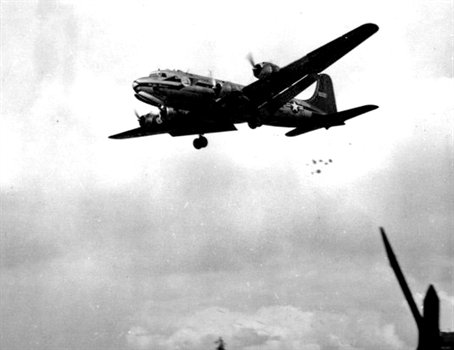The Christmas Candy Bomber
The epilogue to World War II was the massive effort made to recover war-torn Europe. For months and even years following the war times were lean as millions scrambled to recover lives.
U.S. President Harry Truman led a massive effort – dubbed The Marshall Plan – to bring relief to the starving, homeless and unemployed in Europe. Part of that effort was the Berlin Airlift of 1948, a round-the-clock operation of landing planes with relief supplies in Berlin. This is where the story of the Christmas Candy Bomber begins.
Colonel Gail S. Halvorsen, of Provo, Utah, piloted a C-54 aircraft, typical of those used during the Berlin airlift.
One day while waiting for his just-landed aircraft to be unloaded he wandered to a perimeter fence, hoping to take movies of aircraft coming and going. He was surprised to find children who approached him and spoke to him in English.
In an interview with Historynet.com, Halvorsen explains: “They came right up to the barbed wire and spoke to me in English. These kids were giving me a lecture, telling me, “Don’t give up on us. If we lose our freedom, we’ll never get it back.” American-style freedom was their dream. Hitler’s past and Stalin’s future was their nightmare. I just flipped. Got so interested, I forgot what time it was.
I looked at my watch and said, “Holy cow, I gotta go! Goodbye. Don’t worry.” I took three steps. Then I realized—these kids had me stopped dead in my tracks for over an hour and not one of 30 had put out their hand. They were so grateful for flour, to be free, that they wouldn’t be beggars for something extravagant. This was stronger than overt gratitude—this was silent gratitude. How can I reward these kids?
I went back to the fence and pulled out my two sticks of Wrigley’s Doublemint, broke them in half and passed the four pieces through the barbed wire. There was no fight. The kids who got gum carefully tore the tin foil and passed it to the others, who put it up to their noses to smell—just smelled it—and I stood there dumbfounded. I told them, “Come back here tomorrow, and when I come in to land, I’ll drop enough gum for all of you.”
He would drop them from his plane as he passed over. As a signal to the kids, Halvorsen promised to “wiggle his wings” as he approached their position.
True to his word, on his next mission to Tempelhof Airport, on final approach to the runway Halvorsen “wiggled his wings” and had the Flight Engineer push three bundles of sweets through the flare chute on the C-54 flightdeck. (Halvorsen had gathered the candy by talking other pilots into donating their Candy Ration Cards to the effort.)
The three small parcels floated down on tiny, homemade handkerchief parachutes, but Halvorsen could not see whether the children caught the packages due to the business of landing. Later, as he taxied the empty C-54 to the end of the runway to depart the airfield, he looked to the crowd of children at the fence. Three white handkerchiefs waved back at him enthusiastically.
Over the next several weeks Halvorsen made many drops of candy and gum to an ever-growing crowd of appreciative German kids.
Since he was unsure about how the air force would react, he avoided talking about what he was doing. He was called in by his commander any way a few days later.
“What have you been doing?” queried the senior officer. To Halvorsen’s surprise, his commander told him that a candy bar that had been dropped on the end of a runway had hit a German reporter in the head, and the story was now all over the front pages in Berlin.
“The German people loved it and that kept me from getting into trouble. My commander thanked me for the good idea and gave permission to continue the candy flying,” said Col. Halvorsen.
The servicemen were by now contributing not only their candy rations but also their handkerchiefs. They soon ran out of handkerchiefs, and the men donated shirtsleeves to be used as parachutes. Finally they began attaching notes asking that the parachutes be returned to use again; most were.
Before long letters of appreciation began to arrive for “Uncle Wiggly Wings”. Some of those letters requested candy drops at other locations in the city.
News of the candy bomber spread in the media and other folks inside and outside of the military asked how they could help.
Back in the United States, where the media had picked up the story, Halvorsen was asked what he needed to continue his run as the Candy Bomber. “Boxcars full of candy!”, he jokingly replied.
When Halvorsen returned to Germany 3000 pounds of chocolate had arrived for him to deliver and thousands of pounds more began to flow from the United States to keep the effort alive.
Six months later “Operation Little Vittles”, as the effort came to be called, made a special Christmas drop in an effort to reach as many kids as possible with candy, treats, small toys and necessary supplies through the handmade parachutes.
Uncle Wiggly Wings was not beloved by all. In an attempt to reach children in East Berlin, Halvorsen dropped candy bombs over objections from the occupying forces of the Soviet Union. He was berated by them for the “attempted subversion of young minds”.
Not every kid could snag one of Halvorsen’s little white parachutes with candy treats. Disappointed children who wrote in to say they could not catch what came from the sky were sent candy instead by Halvorsen in the mail.
Col. Halvorsen said that children sometimes wrote to him with special requests. “I received one letter with a beautiful map in it. The little girl said hers was the white house with the chickens in the backyard and that she would be waiting there at 2:00 P.M. I never found her house so I mailed her a package.”
Twenty years later when Col. Halvorsen returned to Tempelhof as commander of the base, the same girl, now grown up with a family of her own, wrote to him again. She invited him to dinner in the same home he had failed to find during the airlift. The two families still keep in touch with each other.
Another letter Col. Halvorsen received was from a little boy named Peter Zimmerman who had lost both his parents in the war. He asked the candy bomber if he could find him some people in America who would adopt him. Col. Halvorsen helped to locate a family in Pennsylvania who welcomed Peter into their home.
The story of Halvorsen’s life as the Candy Bomber continues. In 2012 he was the guest of Tom Brokaw, who narrated the story of the Candy Bomber as “the spirit of Christmas” for the annual Christmas concert of the Mormon Tabernacle Choir. A spy 92 year old Halvorsen, still able to fit into the flight suit he wore back in 1948, stole the show with his comments about giving and service.



